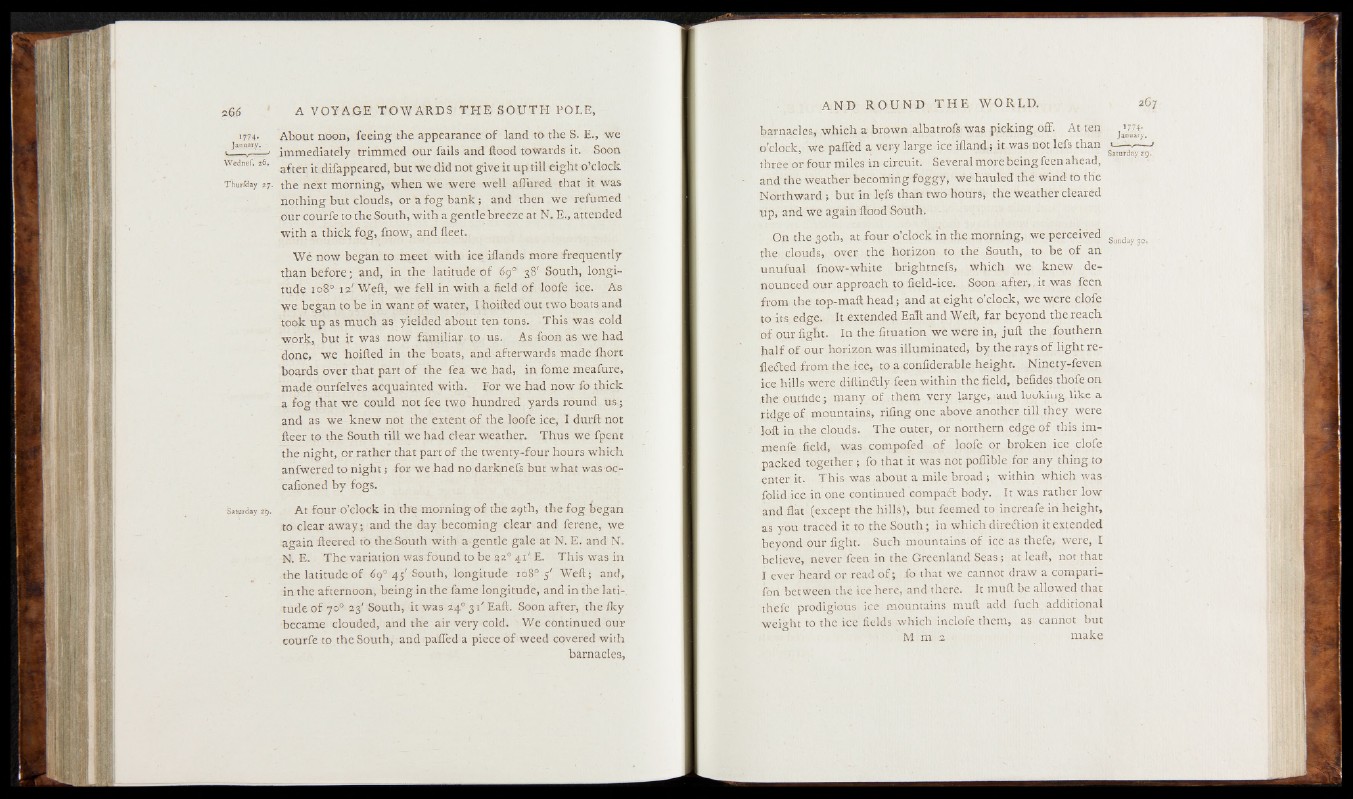
1774* About noon, feeing the appearance of land to the S. E., we
■ h"uary- , immediately trimmed our fails and flood towards it. Soon
Wednef. 26. ^ . -t difappeared, but we did not give it up till eight o’clock.
Thuifday 27. the next morning, when we were well allured that it. was
nothing but clouds, or a fog bank; and then we refumed
our courfe to the South, with a gentle breeze at N. E., attended
with a thick fag, fnow, and fleet.
We now began to meet with ice illands more frequently
than hefore; and, in the latitude of 69° 38' South, longitude
1080 12' Weft, we fell in with a field of loofe ice. As
we began to. be in want of water, I hoifted out two boats and
took up as much as yielded about ten tons. This was cold
work, but it was now familiar to us. As foon as we had
done, we hoifted in the boats, and afterwards made fhort
boards over that part of the fea we had, in fome meafure,
made purfelves acquainted with. For we had now fo thick
a fog that we could not fee two hundred yards round us;
and as we knew not the extent of the loofe ice, I durft not
fleer to the South till we had clear weather. Thus we fpent
the night, or rather that part of the twenty-four hours which
anfwered to night; for we had no darknels but what was oc-
cafloned by fogs.
Saturday 29. At four o’clock in the morning of the 29th, the fog began
to clear away; and the day becoming clear and ferene, we
again fleered to the South with a gentle gale at N. E. and N.
N. E. The variation was found to be 220 41' E. This was in
the latitude of 69° 45' South, longitude 108° 5' Weft; and,
in the afternoon, being in the fame longitude, and in the latitude
of 70° 23' South, it was 240 31' Eaft. Soon after, the Iky
became clouded, and the air very cold. We continued our
courfe to the South, and paired a piece of weed covered with
barnacles,
barnacles, which a brown albatrofs was picking off. At ten
o'clock, we palled a very large ice illand; it was not lefs than 87777^7
three or four miles in circuit. Several more being feen ahead,
and the weather becoming foggy, we hauled the wind to the
Northward ; but in lefs than two hours, the weather cleared
up, and we again flood South.
On the 30th, at four o’clock in the morning, we perceived Su[iday *
the clouds, over the horizon to the South, to be of an
unufual fnow-white brightnefs, which we knew denounced
our approach to field-ice. Soon after, ,it was feen
from the top-maft head; and at eight o’clock, we were clofe
to its edge. It extended EaTl and Weft, far beyond the reach
of our fight. In the fituation we were in, juft the fouthern
half of our horizon was illuminated, by the rays of light reflected
from the ice, to a confiderable height. Ninety-feven
ice hills were diftinctly feen within the field, befides thofe on
the outfide; many of them very large, and looking like a
ridge of mountains, riling one above another till they were
loft in the clouds. The outer, or northern edge of this im-
menfe field, was compofed of loofe or broken ice clofe
packed together ; fo that it was not polfible for any thing to
enter it. This was about a mile broad ; within which was
folid ice in one continued compact body. It was rather low
and flat (except the hills), but feemed to increafe in height,
as you traced it to the South; in which direction it extended
beyond our light. Such mountains of ice as thefe, were, I
believe, never feen in the Greenland Seas; at leaft, not that
I ever heard or read of; fo that we cannot draw a compari-
foii between the ice here, and there. It muff be allowed that
thefe prodigious ice mountains muft add fuch additional
weight to the ice fields which inclofe them, as cannot but
M m 2 make